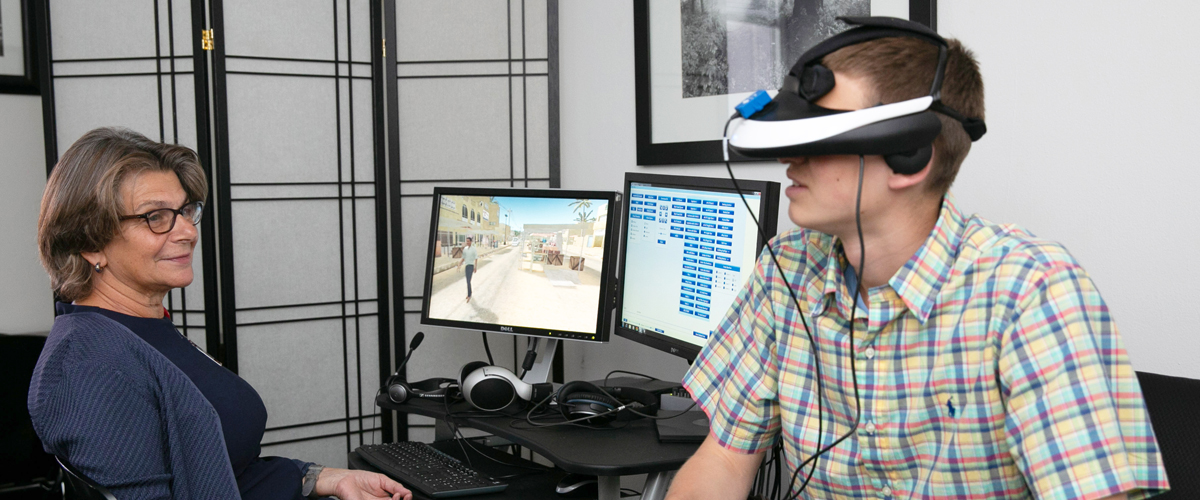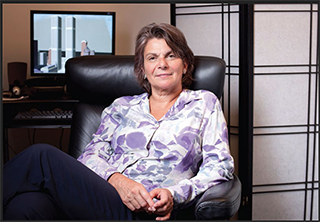Is Virtual Reality the Future of Trauma Treatment?
For more than two decades, Dr. JoAnn Difede has pioneered the use of virtual reality to help treat military members, 9/11 survivors, health care workers and others suffering from post-traumatic stress disorder. Learn how her journey into VR began and where she’s hoping to take it next.

Dr. JoAnn Difede, left, uses VR technology to help create sensory-rich scenarios for her patients.

Dr. JoAnn Difede, left, uses VR technology to help create sensory-rich scenarios for her patients.
You’re a nurse in an intensive care unit. You’re checking in on a row of COVID-19 patients laying in their beds. The beeping of monitors and the sound of ventilators fill the air. Just then, a new patient is wheeled in; you rush over to help.
Except you aren’t in the ICU. You’re in an office with a virtual reality (VR) headset over your eyes, and a trained psychologist is helping treat your post-traumatic stress disorder (PTSD). The office of JoAnn Difede, Ph.D., director of the Program for Anxiety and Traumatic Stress Studies at NewYork-Presbyterian and Weill Cornell Medicine, serves as a place where those suffering from PTSD — including active-duty military, veterans, 9/11 first responders and survivors, and, very soon, health care workers — can receive virtual reality exposure therapy. To date, she and her team have treated hundreds of patients at NewYork-Presbyterian and Weill Cornell Medicine.
Dr. Difede has spent more than 20 years working with PTSD patients. She is a pioneer in using virtual reality to develop therapies to treat PTSD that immerse people in sensory-rich scenarios based on their experiences to help them face and move past their trauma. “The idea is that by going over and over it again as if it were happening, your brain learns that it actually happened in the past, and that you’re safe now,” says Dr. Difede, who is also a psychologist at NewYork-Presbyterian/Weill Cornell Medical Center and a professor of psychology in psychiatry at Weill Cornell Medicine. “We’re helping people walk through a horrifically difficult situation to help them find a way out.”
How Virtual Reality Exposure Therapy Works
Patients who have PTSD suffer from traumatic memories that can manifest as nightmares and flashbacks, causing irritability, difficulty sleeping, hypervigilance, and more. Some patients may be able to lessen their symptoms by recounting their trauma verbally to a psychologist, also known as prolonged exposure therapy, but others may be too numb to fully engage with the memory.
“We’re not just verbal creatures, which is the way psychotherapy’s typically done. In the virtual environment, you can use sensory stimuli to help emotionally engage the person,” says Dr. Difede. “The sensory imagery is very vivid for trauma memories. Sounds, smells, and sights can evoke a fear response.”
Many of the scenarios Dr. Difede uses can be customized. As the patient experiences the computer-generated environment using either a headset or a headset with controllers, they describe the traumatic experience to Dr. Difede (or a trained psychologist on her team) who is sitting nearby. She can see the virtual images on a computer screen and manipulate details. For example, in a combat scenario for Iraq War veterans, Dr. Difede can remove other characters from the environment if the person was alone at the time of the traumatic event, summon a sandstorm, create an explosion, or introduce the sound of shooting. She might even incorporate smells, like spices, into the treatment.

Dr. JoAnn Difede
“A big part of trauma is avoidance — we’re wired to avoid what we’re afraid of,” Dr. Difede says. “The idea behind virtual reality exposure therapy is that you’re systematically and gradually introduced to your trauma in a way that it invokes a level of anxiety that you can tolerate as you walk through or experience the trauma again.”
Working with computer programmers and engineers, Dr. Difede and her colleagues strive to build environments that are realistic and full of sensory detail. To build scenarios for those who served in the wars in Iraq and Afghanistan, they collected feedback from clinicians and veterans around the country. And most recently, to build scenarios for health care workers who have experienced trauma during the pandemic, they ran focus groups to understand what it was like for nurses, doctors and other hospital essential workers in various situations.
An Accidental Pioneer
Dr. Difede originally came to NewYork-Presbyterian and Weill Cornell Medicine as a graduate student to do research in psychoneuroimmunology to study the effect of stress on the immune system. While working with burn patients, she realized those suffering from panic attacks and sleeplessness had no real options for interventions.
Much of this had to do with the fact that the current diagnosis of PTSD, a psychiatric disorder that occurs when people directly experience or witness an event that is life-threatening or can cause serious harm, was only solidified in the years leading up to 9/11. There was controversy for many decades about symptoms and causes, including the fact that it is the only psychiatric disorder that requires an external event. “So imagine, if you can’t agree on what the phenomenon is, how can you study it and how can you develop treatments for it?” says Dr. Difede.
Dr. Difede’s mentor, the late Dr. Samuel W. Perry of NewYork-Presbyterian/Weill Cornell Medical Center, who focused on PTSD, encouraged her to write a grant to address this void. So she and her colleague, Dr. Hunter Hoffman at the University of Washington, began planning a VR simulation of a fire to help treat PTSD in burn survivors.
Then came 9/11. “Thousands of people were exposed to the World Trade Center attack,” says Dr. Difede. “We knew then that we certainly didn’t have a cure and barely had a treatment for PTSD. We saw it as a public health problem. People’s lives can be ruined by trauma.”
Dr. Difede and her collaborators pivoted their work to create a virtual reality simulation based on the terrorist attack, incorporating details that many people remembered from that day — the bright blue sky, the sight and sounds of the plane crash, the rumbling of the World Trade Center after it was hit — and conducted a study with those who witnessed the attack to see if virtual reality exposure therapy could help them with their PTSD.
The results suggested VR could be especially useful for patients for whom imaginal exposure therapy (recounting the traumatic experience based on their imagination) was not enough. “I’ll never forget the first patient we treated in the study with the 9/11 simulation. She was numb and irritable and telling her story in a flat way,” recalls Dr. Difede. “She put on the head-mounted display and was immersed in the virtual world and started to cry. She said, ‘Oh my God, I never thought I’d see the World Trade Center again.’” The patient went on to improve dramatically, she says.
“People who need mental health treatment typically don’t get it, so VR may be a way to make people more willing to try it.”— Dr. JoAnn Difede
Advancing Knowledge, Expanding Treatment
Dr. Difede’s work with virtual reality exposure therapy has only continued to evolve. From there, she began her research on combat-related PTSD, collaborating on studies and developing treatments with the help of a $15 million grant from the Department of Defense. Most recently, she and her colleagues published research that shows VR exposure therapy may be particularly beneficial in treating PTSD in veterans and active-duty military who also suffer from depression. Her work with military also includes treating current and former service members and their families through the NewYork-Presbyterian Military Family Wellness Center, where she serves as co-director.
And in her more recent work with health care workers, she’s hoping to test whether it’s more therapeutic for patients to see themselves as avatars in the third person versus the first-person. “We’ve all learned a lot about moral injury now and how a lot of health care workers, soldiers, and other groups who serve people feel they couldn’t live up to their values and their skill sets,” Dr. Difede says. “So one of the questions we are considering is, if you see what happened to you and your colleagues, the pace you were moving at and what you experienced, will it help ease some of the guilt and pain you feel?”
As the treatments and technology evolve, Dr. Difede’s hope is that people suffering from PTSD will be more willing to seek help. “Some of our research, and that of others, shows that patients wanted the VR and preferred it,” Dr. Difede says. “People who need mental health treatment typically don’t get it, so this may be a way to make people more willing to try it.”
Dr. Difede recalls receiving a text from a patient she treated during the 9/11 study. It read: “I want you to know I got my life back.”
“It’s immensely rewarding to see someone get better,” she says. “That is why we get into health care and research.”
Additional Resources
Learn more about trauma treatment at the Program for Anxiety and Traumatic Stress Studies and the mental health services offered at the NewYork-Presbyterian Military Family Wellness Center.

